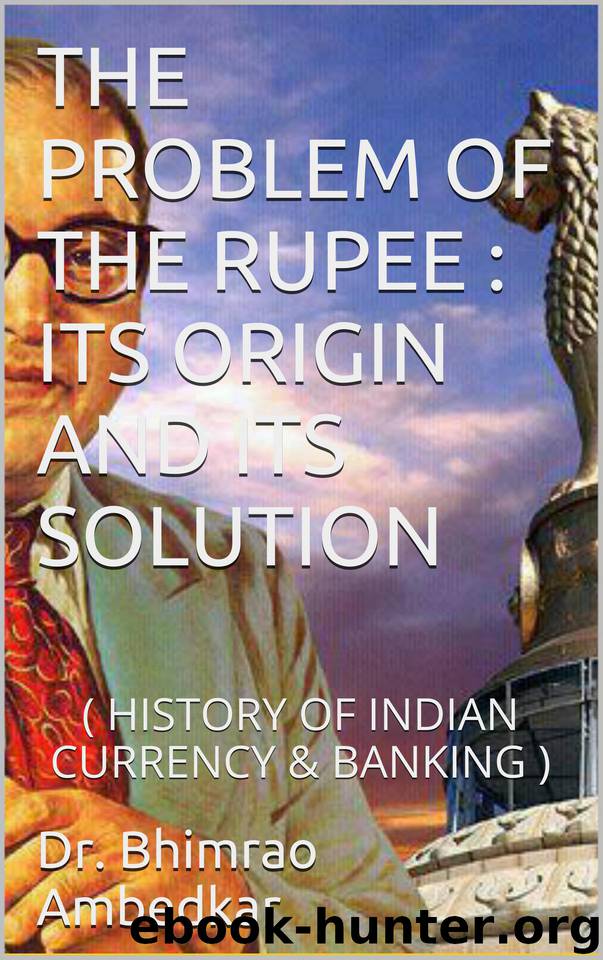THE PROBLEM OF THE RUPEE : ITS ORIGIN AND ITS SOLUTION: (HISTORY OF INDIAN CURRENCY & BANKING) by Ambedkar Dr. Bhimrao

Author:Ambedkar, Dr. Bhimrao [Ambedkar, Dr. Bhimrao]
Language: eng
Format: epub
Published: 0101-01-01T00:00:00+00:00
Mr. Lindsay, on the other hand, followed on lines quite different from those adopted by Mr. Probyn. He proposed
[f70] that the Government should offer to sell, without iimit on the one hand, rupee drafts on India at the exchange of 16 1/16d. the rupee, and on the other hand, sterling drafts on London at the rate of exchange of 15 3/4d. the rupee. The funds necessary for the transactions were to be kept separate from the ordinary Government balances in " Gold Standard " Offices in London and in India. The London Office was to be kept in funds to meet drafts drawn on it—
(1) by borrowing in gold to the extent of five or ten million sterling;
(2) by the receipts realised by the sale of drafts on India:
(3) by the receipts realised by the sale of silver bullion in rupee melted down;
[f71] and
(4) when necessary, by further gold borrowing.
The Indian Gold Standard Office was to be kept in funds to meet the drafts drawn on them—
(1 ) by the receipts realised by the sale of drafts on London ; and
(2) by the coinage when necessary of new rupees from bullion, purchased by the London Gold Standard Office and sent to India.
The principal point of difference between the scheme of currency advocated by the Government of India on the one hand and that put forth by Messrs. Probyn and Lindsay consisted in the fact that the former proposed to establish a gold standard with a gold currency, while the latter proposed to establish a gold standard without a gold currency.
To adjudicate upon the relative merits of a gold standard with a gold currency and a gold standard without a gold currency, the Secretary of State appointed another departmental Committee, under the chairmanship of Sir Henry Fowler. After taking a mass of important evidence, the Committee observed
[f72] :—
" 50. On this scheme [of Mr. Probyn] we remark that, while bullion may be regarded as the international medium of exchange, there is no precedent for its permanent adoption for purposes of internal currency; nor does it accord with either European or Indian usage that the standard metal should not pass from hand to hand in the convenient form of current coin. No real support for such a scheme is to be drawn from the purely temporary provisions of " Peel's Act " of 1819, whereby, for a limited period, the Bank of England, as a first step to the resumption of cash payments, was authorised to cash, in stamped gold bars, its notes, when presented in parcels of over £ 200. Little or no demand for gold bullion appears to have been made on the Bank itself in 1821.
****
" 53. It is evident that the arguments which tell against the permanent adoption of Mr. Probyn's bullion scheme, and in favour of a gold currency for India, tell more strongly against Mr. Lindsay's ingenious scheme for what has been termed ' an exchange standard.' We have been impressed by the evidence of Lord
Download
This site does not store any files on its server. We only index and link to content provided by other sites. Please contact the content providers to delete copyright contents if any and email us, we'll remove relevant links or contents immediately.
International Integration of the Brazilian Economy by Elias C. Grivoyannis(57292)
The Radium Girls by Kate Moore(10903)
Turbulence by E. J. Noyes(7033)
Nudge - Improving Decisions about Health, Wealth, and Happiness by Thaler Sunstein(6629)
The Black Swan by Nassim Nicholas Taleb(6184)
Pioneering Portfolio Management by David F. Swensen(5599)
Rich Dad Poor Dad by Robert T. Kiyosaki(5140)
Zero to One by Peter Thiel(4818)
Man-made Catastrophes and Risk Information Concealment by Dmitry Chernov & Didier Sornette(4730)
Secrecy World by Jake Bernstein(3774)
Millionaire: The Philanderer, Gambler, and Duelist Who Invented Modern Finance by Janet Gleeson(3566)
Skin in the Game by Nassim Nicholas Taleb(3456)
The Age of Surveillance Capitalism by Shoshana Zuboff(3413)
The Money Culture by Michael Lewis(3277)
Skin in the Game: Hidden Asymmetries in Daily Life by Nassim Nicholas Taleb(3259)
Bullshit Jobs by David Graeber(3173)
The Dhandho Investor by Mohnish Pabrai(3162)
The Wisdom of Finance by Mihir Desai(3069)
Blockchain Basics by Daniel Drescher(2884)
